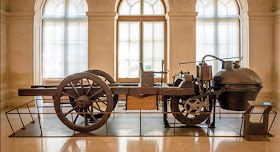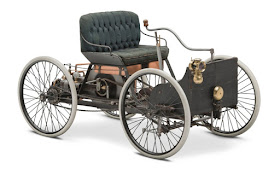History Of The Automobile
Unlike many other major inventions, the original idea of the automobile cannot be attributed to a single individual.
The idea certainly occurred long before it was first recorded in the Iliad, in which Homer (in Alexander Pope’s translation) states that Vulcan in a single day made 20 tricycles, which Leonardo da Vinci considered the idea of a self-propelled vehicle in the 15th century.
In 1760 a Swiss clergyman, J.H. Genevois, suggested mounting small windmills on a cartlike vehicle, their power to be used to wind springs that would move the road wheel.
 |
| The swiss clergyman |
Genevois’s idea probably derived from a windmill cart of about 1714. Two-masted wind carriages were running in the Netherlands in 1600, and a speed of 20 miles (30 km) per hour with a load of 28 passengers was claimed for at least one of them.
The first recorded suggestion of wind use was probably Robert Valturio’s unrealized plan (1472) for a cart powered by windmills geared to the wheels.
Other inventors considered the possibilities of clockwork. Probably in 1748 a carriage propelled by a large clockwork engine was demonstrated in Paris by the versatile inventor Jacques de Vaucanson.
The age of steam
Most historians agree that Nicolas-Joseph Cugnot of France was the constructor of the first true automobile. |
| The Nicolas-Joseph Cugnot |
Cugnot’s vehicle was a huge, heavy, steam-powered tricycle, and his model of 1769 was said to have run for 20 minutes at 2.25 miles (3.6 km) per hour while carrying four people and to have recuperated sufficient steam power to move again after standing for 20 minutes.
Cugnot was an artillery officer, and the more or less steam-tight pistons of his engine were made possible by the invention of a drill that accurately machined cannon bores.
A replica of Cugnot’s second vehicle, partially original, is preserved in the Conservatoire National des Arts et Métiers in Paris.
Development of the gasoline car
Most authorities are inclined to honour Karl Benz and Gottlieb Daimler of Germany as the most important pioneer contributors to the gasoline-engine automobile. |
| The Karl benz |
Benz ran his first car in 1885, Daimler in 1886. Although there is no reason to believe that Benz had ever seen a motor vehicle before he made his own, he and Daimler had been preceded by Étienne Lenoir in France and Siegfried Marcus in Austria, in 1862 and 1864–65, respectively, but neither Lenoir nor Marcus had persisted.
Benz and Daimler did persist—indeed, to such purpose that their successor firm of Daimler AG can trace its origins as far back as 1885. Oddly, Benz and Daimler never met.
The four-stroke principle upon which most modern automobile engines work was discovered by a French engineer, Alphonse Beau de Rochas, in 1862, a year before Lenoir ran his car from Paris to Joinville-le-Pont.
The four-stroke cycle is often called the Otto cycle, after the German Nikolaus August Otto, who designed an engine on that principle in 1876.
De Rochas held prior patents, however, and litigation in the French courts upheld him. Lenoir’s engine omitted the compression stroke of the Otto cycle; fuel was drawn into the cylinder on the intake stroke and fired by a spark halfway on the next reciprocal stroke.
The idea for Marcus’s 1864–65 car apparently came to him by chance while he was considering the production of illumination by igniting a mixture of gasoline and air with a stream of sparks. The reaction was so violent that it occurred to him to use it as a power source.
His first vehicle was a handcart marrying a two-cycle engine geared to the rear wheels without any intervening clutch.
It was started by having a strong man lift the rear end while the wheels were spun, after which it ran for a distance of about 180 metres (about 200 yards).
Marcus’s second model, the 1888–89 car, was sturdy and sufficiently well-preserved to make a demonstration run in the streets of Vienna in 1950, and again in 1987, at a rate of almost 5 km (3 miles) per hour.
In 1898 the Austrian Automobile Club arranged an exhibition of motorcars, and Marcus was a guest of honour.
Ironically, he denied interest in the idea of the automobile, calling it “a senseless waste of time and effort.”
Karl Benz
Karl Benz was completely dedicated to the proposition that the internal-combustion engine would supersede the horse and revolutionize the world’s transportation.He persisted in his efforts to build a gasoline-fueled vehicle in the face of many obstacles, including lack of money to the point of poverty and the bitter objections of his associates, who considered him unbalanced on the subject.
Benz ran his first car, a three-wheeler powered by a two-cycle, one-cylinder engine, on a happy and triumphant day early in 1885.
He circled a cinder track beside his small factory, his workmen running beside the car, his wife running too, clapping her hands; the little machine made four circuits of the track, stalling only twice before a broken chain stopped it.
Even Max Rose, Benz’s skeptical partner, whose money had made the car possible, conceded that he was mildly impressed; but, like Siegfried Marcus, he remained convinced to the end of his association with Benz that there was no future in the horseless carriage.
Benz made his first sale to a Parisian named Émile Roger in 1888.
Gradually, the soundness of his design and the quality and care that went into the material and the construction of his cars bore weight, and they sold well.
That year he was employing some 50 workmen to build the tricycle car; in 1893 he began to make a four-wheeler.
In his way, Benz was almost as dogmatic and reactionary as Marcus had been; he objected to redesign of his original cars, and some authorities believe that he was never really convinced that his original concepts had been improved upon.
Henry Ford and Clara Ford at Fair Lane in the 1896 Quadricycle, 1918.
The 1896 Quadricycle, the first automobile that Henry Ford built, came to symbolize all of the later success achieved by Mr. Ford and Ford Motor Company.





Excellent ...
ReplyDeleteIts a very usefull to all
ReplyDeleteThank you
Delete